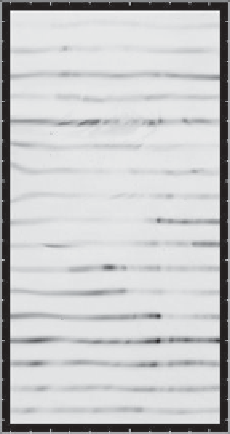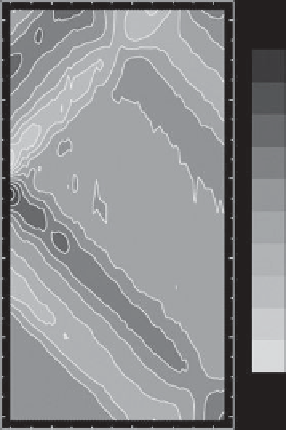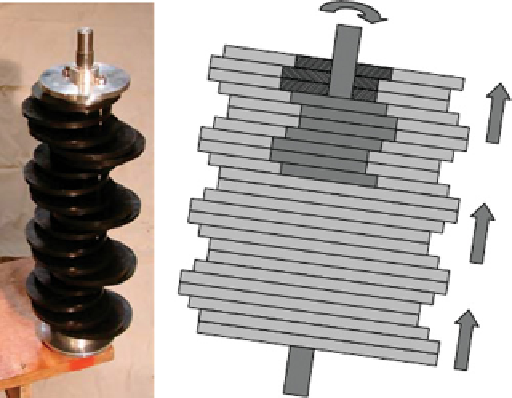Geoscience Reference
In-Depth Information
(a)
(b)
4
0.5
2
0
Z
-2
-4
-0.5
-6
2
4
6
2
4
6
X
X
Figure 10.17.
(a) Dye lines displaced to the right of a sphere oscillating horizontally about the origin in uniformly stratified fluid.
(b) Computed displacement of the lines relative to the oscillating amplitude
A
. Reproduced from Figure 20 of
Voisin et al.
[2011].
large-amplitude forcing is less inclined to result in mixing
of the stratified fluid.
This technique has been used in a variety of circum-
stances that have revealed important processes in the
evolution of internal waves.
Satellite altimetry [
Egbert and Ray
, 2000] has recently
been employed to observe the generation of oceanic
internal waves by tidal flow over the continental margin
and submarine sills. These have revealed the generation of
low vertical-mode internal waves, associated with undula-
tions of the thermocline. As well as theory and numerical
simulations [
Balmforth et al.
, 2002;
Llewellyn-Smith and
Young
, 2002;
Legg
, 2004], laboratory experiments have
been performed to examine the generation of internal
waves by Gaussian hill that oscillated horizontally back
and forth with fixed frequency and amplitude [
Peacock
et al.
, 2008;
Echeverri et al.
, 2009].
An outstanding question is how such low modes trans-
fer their energy to smaller scales (high modes) so that they
ultimately dissipate and mix the ocean.
The laboratory experiments by
Peacock et al.
[2009]
examined one mechanism through which this may occur.
When a low-mode internal wave is incident upon topog-
raphy, the sloping sides of the hill refocus the energy into
beams. This is shown in Figure 10.19.
The waves are created using the mechanism of oscil-
lating stacked horizontal plates using the wave generator
mechanism described above. Here, however, the rotating
shaft is not spiral but is constructed with a vertically
Figure 10.18.
Camshaft and schematic cross section showing
how the rotation of the shaft results in the back-and-forth oscil-
lation of flat plates. Reproduced from Figure 2 of
Gostiaux et al.
[2007].
geometry of the camshaft and whose frequency is set by
the rotation rate.
The mechanism thus acts like towed topography except
that the translation of the periodic boundary is vertical.
It does not generate columnar modes upstream. Nor
is their boundary layer separation behind their crests.
Because the boundary displacements are horizontal,


















